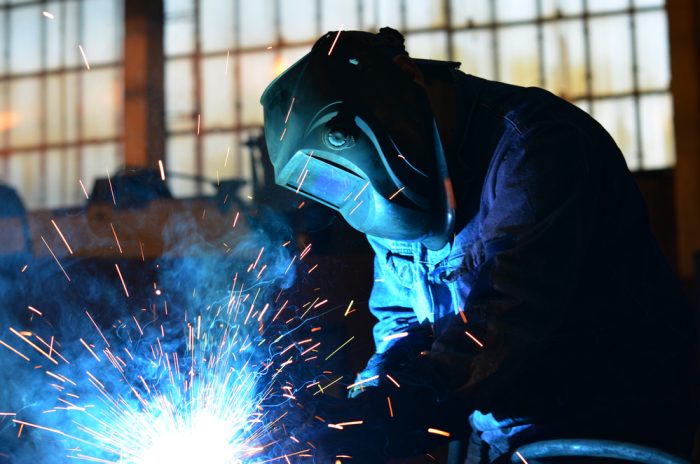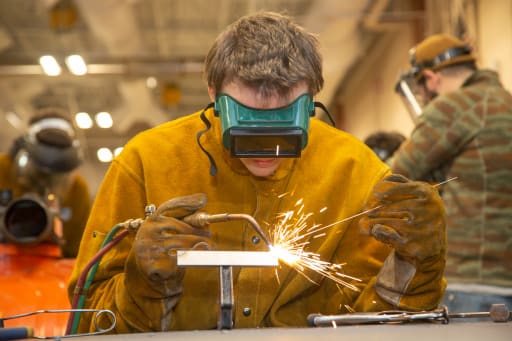All About Welding: Key Insights Into Techniques and Finest Practices for Success
Welding incorporates a variety of methods, each suited for certain products and applications. Comprehending these methods, such as GMAW, SMAW, and TIG, is essential for achieving ideal results. The right equipment and security methods can not be overlooked. As preparation and troubleshooting play vital roles in the welding process, mastering these elements can considerably improve the top quality of the end product. What are the key aspects that ensure a successful weld?
Recognizing Different Welding Strategies
Welding techniques incorporate a range of methods, each fit to specific applications and products. Amongst one of the most usual methods are Gas Metal Arc Welding (GMAW), Secured Steel Arc Welding (SMAW), and Tungsten Inert Gas Welding (TIG) GMAW, likewise recognized as MIG welding, is prominent for its speed and flexibility, making it optimal for thin products. SMAW, or stick welding, is favored for its simplicity and efficiency in outdoor atmospheres, specifically with thicker metals. TIG welding uses accuracy and control, making it appropriate for detailed job and non-ferrous metals (Montana Mobile Welding and Repair Belgrade Welding). Each method has its special benefits and considerations, enabling welders to choose the best method based on the project's demands, product type, and preferred outcomes. Understanding these methods is important for effective welding
Important Welding Tools and Devices
While various welding methods require certain abilities, the best devices and devices are similarly vital for accomplishing quality results. Vital welding equipment includes welding devices, which differ relying on the strategy-- such as MIG, TIG, or stick welding. Safety gear, including aprons, gloves, and headgears, guarantees security and comfort during the procedure. Furthermore, clamps and fixtures aid secure materials in position, guaranteeing accuracy in welds. Consumables like welding poles, cable, and shielding gas are also essential components that influence the quality of the weld. Tools such as cutters and grinders facilitate surface prep work and post-weld finishing, contributing to a specialist outcome. Buying premium tools eventually boosts the efficiency and efficiency of welding tasks.
Security Practices in Welding
Correct safety and security methods are crucial in the welding sector to safeguard employees from prospective hazards. Welders have to wear proper personal safety equipment (PPE), consisting of helmets with appropriate shading, gloves, and flame-resistant clothes. Sufficient ventilation is important to reduce direct exposure to hazardous fumes and gases generated throughout the welding procedure. Furthermore, workers must be learnt the right handling of welding equipment to stop accidents. Fire security actions, such as keeping combustible products far from the welding location and having fire extinguishers easily available, are essential. Routine evaluations of tools and workspaces can help determine possible threats prior to they bring about mishaps. By sticking to these safety and security practices, welders can produce a safer working atmosphere and lessen threats connected with their profession.
Preparing Materials for Welding
Preparing materials for welding is a crucial step that considerably influences the top quality and integrity of the final product (Montana Mobile Welding and Repair Belgrade Welding). Appropriate prep work includes cleaning the surface areas to remove impurities such as dirt, oil, and rust, which can endanger the weld. Strategies such as grinding, fining sand, or using solvents are typically used to achieve a clean surface area. Additionally, making sure that the products fit with each other well is vital; spaces can lead to weak welds. It's also crucial to take into consideration the positioning and positioning of the components, as this will certainly impact the convenience of welding and the final outcome. Selecting the proper filler product and making sure compatibility with the base metals is important for attaining solid, sturdy welds.
Tips for Getting High-Quality Welds
Achieving premium welds needs attention to information and adherence to ideal techniques throughout the welding process. Proper joint preparation is necessary, ensuring surfaces are tidy and totally free from contaminants. Selecting the proper filler material and welding method based on the base steels is vital for suitable bonding. Keeping constant traveling rate and angle while welding can advertise and avoid flaws uniformity. Additionally, managing heat input is vital; too much warm can bring about bending and compromised joints. If necessary, frequently examining the welds during the procedure permits for instant modifications. Ultimately, employing proper post-weld treatments, such as cleaning and stress alleviation, can enhance welding aluminum to steel the resilience and honesty of the weld, eventually making certain an effective end result.
Repairing Common Welding Issues
Welding usually provides obstacles that can influence the high quality and integrity of the final item. Typical concerns such as porosity, irregular weld beads, and getting too hot can arise, each requiring details fixing methods. Understanding these issues is important for welders to boost their abilities and attain suitable results.
Porosity Problems Discussed
Porosity can typically be ignored, it remains an important concern in welding that can compromise the honesty of a completed product. Porosity describes the existence of tiny gas pockets within the weld bead, which can lead and weaken the joint to early failure. This issue normally occurs from contaminants, wetness, or inappropriate securing gas insurance coverage throughout the welding process. To minimize porosity, welders should confirm that the base materials are dry and tidy, use suitable securing gases, and preserve constant welding criteria. Consistently inspecting the devices and setting can likewise aid recognize potential concerns before they show up in the weld. Addressing porosity properly is essential for accomplishing strong, durable welds that satisfy high quality standards.

Inconsistent Weld Beads
Irregular weld grains can considerably affect the high quality and strength of an ended up product. Numerous aspects add to this concern, consisting of inappropriate travel rate, inaccurate amperage settings, and inconsistent electrode angles. When the welder moves too promptly, a bead might show up slim and do not have penetration, while relocating also gradually can cause excessive buildup. Additionally, making use of the incorrect amperage can lead to either undercutting or excessive spatter, both of which compromise weld stability. The welder's method, such as irregular torch activity, can additionally cause uneven grain look. To alleviate these issues, welders ought to concentrate on preserving steady, regulated movements and guaranteeing proper equipment setups to accomplish harmony in their welds. Consistency is essential to attaining trustworthy and solid welds.
Overheating and Bending Issues
Extreme warmth during the welding procedure can lead to significant overheating and buckling problems, impacting the architectural stability of the workpiece. These problems typically materialize as distortion, which can endanger alignment and fit-up, making further setting up testing. Variables contributing to overheating include the option of welding parameters, such as voltage and take a trip rate, along with the sort of material being bonded. To reduce these problems, welders must preserve regular travel rate and ideal warm input while keeping track of the workpiece temperature. Additionally, pre-heating or post-weld warm treatment can aid minimize tensions brought on by quick air conditioning - Montana Mobile Welding and Repair. Normal inspection and adherence to finest methods are vital in protecting against getting too hot and ensuring the durability and dependability of bonded structures
Often Asked Questions
What Are the Job Opportunities in the Welding Market?
The welding sector supplies diverse profession chances, including placements as welders, engineers, educators, and assessors. Professionals can work in production, building, aerospace, and vehicle fields, gaining from strong need and affordable incomes in various roles.
Just How Can I Boost My Welding Rate Without Compromising Quality?
To enhance welding speed without giving up high quality, one need to exercise efficient techniques, maintain tools, enhance setups, and boost hand-eye coordination. Routine training and looking for feedback can also considerably add to attaining much faster, high-grade welds.
What Qualifications Are Readily Available for Welders?
Various qualifications exist for welders, including those from the American Welding Society (AWS), the National Facility for Building And Construction Education and Research (NCCER), and different industry-specific companies. These credentials improve employability and demonstrate skill effectiveness.
Exactly How Does Welding Influence the Features of Metals?
Welding affects the residential or commercial properties of metals by modifying their microstructure, which can cause adjustments in solidity, strength, and ductility. Warmth input and cooling rates throughout the process greatly influence these product features.
Can I Bonded Dissimilar Metals With Each Other?
